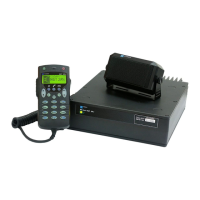NGT—Checks and adjustments
NGT Transceiver System Technical Service Manual 181
1 Release PTT.
1 Check that the two-tone waveform is clean and undistorted.
If it is not clean and undistorted, further analysis is required.
To adjust the high output power:
1 Select any channel frequency between 4 and 6 MHz.
1 Connect an average or PEP power meter with a 50 Ω dummy load to the RF
connector ( ).
1 Connect an oscilloscope via a 47 kΩ resistor to the antenna connector.
1 Set the oscilloscope timebase to 500 µs per division and the trigger to auto.
1 Connect a signal generator to provide two-tone audio (700 Hz and 2300 Hz) via the
test unit to:
• the audio input on the 15-way GPIO connector on the junction box or 2012 RF
Unit (see Figure 40 on page 170), or
• the 2011 RF Unit via the NGT test handset (see Figure 41 on page 170)
1 Hold down PTT, then adjust the two-tone level for compression.
1 Adjust the Y sensitivity of the oscilloscope for on-screen display and adjust the
trigger for a stationary waveform.
1 Adjust the two-tone balance control for good crossover display.
1 Adjust HI PWR (R32) (see Figure 34 on page 163) for the required output.
Table 48: Power output PEP vs measuring instrument (12/100/125 W)
Power Output PEP 12 W 100 W 125 W
Peak reading meter 12 W 100 W 125 W
RMS reading meter 6 W 50 W 62.5 W
Average reading meter (e.g.
Bird Model 43)
5 W 40.5 W 50.6 W
Oscilloscope 69 V p–p 200 V p–p 224 V p–p
ALTERNATIVE TEXT
Drawing 08-05910 (sheet 1)
NOTE If the PCB issue status is -04 or earlier, see drawing 08-05910 (sheet 1).
NOTE
The transceiver does not have to be in Service mode to make this
adjustment.
NOTE
The output power is factory-set, so it is not likely to be outside the
specified limits. Check that there are no faults with the transmitter circuits
before attempting to adjust the output power.

